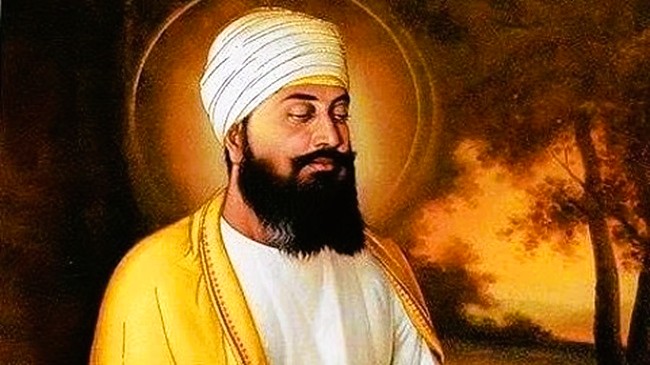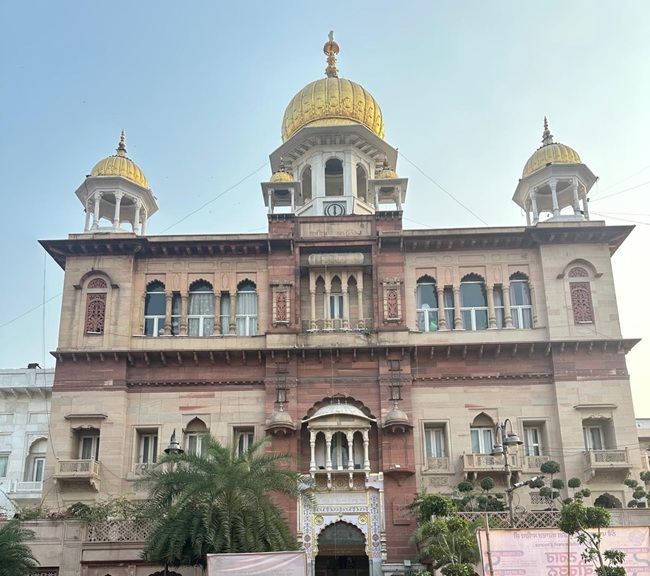Nov 17, 2025
Nov 17, 2025

On the occasion of the 350th anniversary of martyrdom (November 24, 2025) of Guru Tegh Bahadur Ji, let us remember the great sacrifice as well look in his own bani, about his views on death. He has summed the fate of the dead body in two short and crisp lines as under:

“Ghar kee naar bahut hit jaa siau sadhaa rahat sang laagee.
Jub hee hans tajee ieh kaaiaa pret pret kar bhaagee.2.”
– (SGGS, Pg. No. 634)
Translation: Your wife, whom you love so much, and who remained ever attached to you, runs away crying, "Ghost! Ghost!", as soon as the swan-soul leaves this body.
This is an authentic and universal stark reality of ephemeral nature of life. In an instant even the most intimate relationships end, and the dead body is cremated or buried as per the family traditions. No one likes to keep the dead body or be near it. In fact, in western societies the law requires that one has to keep the body in a funeral home, before the last rites. Even the closest and intimate human relationships are essentially for those living alone. Guru Ji even noticed this aspect on how quickly the body is disposed of in these words:

“Tun te praan hott jab niaare Terat pret pukaar.
Aaadh gharee kouoo neh raakhai ghar te dhet nikaar.”
– (SGGS, Pg. No. 536)
Translation: When the soul is separated from the body, then they will cry out, calling you a ghost. No one will let you stay, for even a while; they drive you out of the house.
The closest relation has ended while the body is called a ghost and driven out. But in the case of Guru Tegh Bahadur Ji, we see a new reality unveiled. Guru Ji did not die a normal death, even his dead body defied the normal fate. Guru Tegh Bahadur Ji sacrificed his life for the protection of Hindu faith in Delhi, during the reign of Aurangzeb. Under strict orders of forced conversions by the ruler Aurangzeb, the Hindus were forced to relinquish their faith in order to get relief from Jazia Tax and to save their lives. The poorer and lower caste Hindus had reconciled with the easier option by accepting the conversion. Now, the thrust was on converting the higher caste Hindus-Brahmins, which will accelerate the conversion process due to the cascading effect. Alarmed Brahmins of Kashmir held their conclave and decided to seek help of Guru Tegh Bahadur Ji in Anandpur. Their delegation of five hundred under the leadership of Kirpa Ram came to Anandpur and narrated their plight to Guru Ji. Guru Ji after deliberations and input from his young son Gobind Rai of 9 suggested to Kirpa Ram a message for the ruler. The message was that the Emperor Aurangzeb should stop mass persecution, and if Guru Tegh Bahadur Ji converted to Islam then they all would follow suit.
On hearing the message Aurangzeb was elated and issued orders for Guru Ji’s arrest and to be brought to Delhi. In the meantime, Guru Ji came to know of the royal edict, and started his preparations for Delhi, without waiting for the formal summons to be delivered. Guru Ji was accompanied by five beloved Sikhs and was arrested near Ropar while heading towards Delhi. He was initially interned at Bassi Pathana in Sirhind for about 3 months and then transferred to Delhi on November 04, 1675. Bewildered, Aurangzeb asked Guru Ji, why he was offering himself for Hindus, whose idol worship and caste system was not practiced and preached by founding Sikh Guru Nanak Dev or any subsequent Gurus? Guru Ji replied that Hindus are being treated as sub-humans and inferior in your reign, which is not fair. Guru Ji condemned use of force for conversion to Islam, adding that everyone should have freedom to practice their belief and faith. Guru Ji was then asked to show some miracles, which he firmly refused. Finally, he was told in clear terms that another option to not accepting Islam was to be prepared for death.
First Guru Ji’s companions Bhai Mati Das, Bhai Sati Das, Bhai Dyala were tortured and killed by sawing in half, boiling in a cauldron and wrapping in cotton and being put on fire respectively. However, all three stayed calm and steadfast in their faith, by willingly embracing death. Aurangzeb was hoping that seeing the persecution of his close associates should waiver Guru Ji’s determination, because of his concern for their welfare, and also concern of his own fate.
However, when Guru Ji’s determination did not waiver, Guru Ji was beheaded on November 11, 1675, by Jalaludin at Chandni Chowk on the orders of his chief. The sacrifice touched the hearts of masses. People burst into loud shrieks, lamenting, with tears dropping from their eyes.

Gurdwara Sis Ganj, Delhi.
Today, a memorial Sis Ganj Gurudwara stands there in that place honoring that unique and supreme sacrifice.
The ruler and his coterie had planned that the next day the body would be cut to pieces and hung on the various gates of Delhi, as a message of deterrence for the residents. However, suddenly large dark clouds enveloped the sky unleashing a severe dust storm, as if nature was also expressing solidarity with the grieving masses. Unprepared for the sudden storm everyone started running for their own safety seeking shelter.

Gurdwara Sis Ganj, Anandpur Sahib
Bhai Jaita Ji picked up Guru Ji’s head, wrapped it in an old shawl that he had, and hurried away towards Anandpur Sahib. There, he presented it reverently to Guru Gobind Rai (later Singh) Ji, who calmly received the head without an emotional outburst of tears of pain and sadness. Guru Ji was very impressed by the devotion and courage that Bhai Jaita Ji displayed through this daring act. Guru Ji hugged Bhai Jaita Ji and affectionately declared; “O Rangreta, you are Guru’s son.” Mata Gujar Ji, wife of Guru Teg Bahadur Ji came forward and bowed before her husband’s severed head and prayed to Almighty to give her strength and courage in carrying out her duties with the same exemplary determination as displayed by her husband. Guru Gobind Singh Ji summed up the feat in these words:

“Tilak janjoo raakhaa prabh taa kaa. Keeno baddo kaloo meh saakaa.
Saadhan het itee jin karee. Sees dheeaa par see na aucharee.13.”
– (Dasam Granth, Pg. No. 54)
Translation: He protected (with his life) the forehead mark and sacred thread (of the Hindus), which marked an unparalleled heroic event in the Dark Age. For the sake of saints, he laid down his head without a groan.
These words do perfectly paint and convey a true assessment of the momentous task undertaken by Guru Ji for rights of the Hindus to practice their beliefs freely. We cannot find another instance or a parallel, where someone lays down their lives for the protection of another’s faith. But we can find quite a few examples, when someone laid down his own life for the protection of his belief and faith. Guru Gobind Rai arranged the cremation rites of the severed head in the compound of their residence. There stands a magnificent Gurudwara commemorating this unparalleled feat, where thousands visit daily and bow their heads.
In the meantime, the body was picked up by Bhai Lakhi Shah, who happened to be in the vicinity unloading lime from his carts at the Red fort for royal forces. He quietly lifted the body despite the raging storm on his bullock cart and moved it to Raisina, his home. Driving the cart with the body into his house, set the house on fire to cremate the body while creating an impression of accidental fire. Here, we can see a devotee and man of faith, bringing a dead body inside his house, contrary to normal traditions when everyone normally takes the body out. While the people are afraid to visit the cremation grounds in the darkness of the night, this place has become a place of reverence and is visited by thousands day and night.

Gurdwara Rakab Ganj, Delhi. Image (c) istock.com
Today, we have befitting memorials at Chandi Chowk, Rakab Ganj, Raisina in Delhi, where the martyrdom actually took place and the body was cremated. There is also a memorial Gurudwara Sis Ganj, Anandpur Sahib where the head was cremated. Also, there is another memorial called Gurudwara Sheesh Ganj, Taraori, in Karnal district, commemorating the stay of Bhai Jaita there, for a night’s rest on his journey to Anandpur. Recently a new memorial, called Guru Tegh Bahadur Memorial park on the G.T. Road towards Karnal has been built in honor of the indomitable spirit of Guru Ji and his three companions.
We have seen how these numerous memorials commemorate the indomitable spirit of Guru Ji’s supreme sacrifice. Now, let us visit the burial site of the ruler who perpetuated this gory act. The tomb of Aurangzeb is in Aurangabad, the city named after him. There is no canopy over the tomb and hardly any visitors come to honor him. In contrast, the indomitable spirit and supreme sacrifice of Guru Tegh Bahadur Ji is strongly itched in the memory of the masses who make daily pilgrimages there. It continues to inspire people today and will continue to do in the time to come. The universal truths that Guru Ji expounded about the fate of the dead body, does not apply to his body, as Guru Ji was one with the Creator plus his sacrifice did to protect freedom of Hindus to practice their faith. Guru Gobind Singh Ji has penned the following about the Supreme Sacrifice:

Tegh Bahadur kae chalat bhayo jagat ko shok,
hai hai sabh jag bhayo, jai jai jai surlok.”
– (Dasam Granth, Pg. No. 54)
Translation: At Tegh Bahadur’s departure, the whole world was plunged in grief. They hailed his sacrifice, even the celestial realms echoed with his glory.
Reference:
1. Singh, Ranbir. Guru Tegh Bahadur – Divine Poet, Savior & Martyr
2. Singh, Hakam and Chadha, Jaswinder Singh. Guru Tegh Bahadur – His Life, His Martyrdom, His Hymns
3. Kaur, Dr. Amrit. Sri Guru Tegh Bahadur Sahib: The Prophet and Martyr. The Sikh Review, July 2017 issue
4. Padam, Piara Singh. Guru Tegh Bahadur Simareyae
5. Singh, Satbir. Iti Jan Karee – Life Sri Guru Tegh Bahadur Ji
15-Nov-2025
More by : Bhupinder Singh